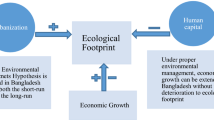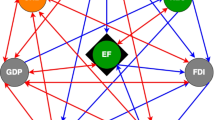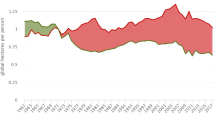Abstract
This study investigates the environmental Kuznets curve (EKC) hypothesis by employing the ecological footprint (EF) as an indicator of environmental degradation in Qatar over the 1980–2011 period. The results of the Autoregressive Distributed Lag (ARDL) estimation with structural breaks reveal that there is a long run relationship among the selected variables with a significant shift in the cointegration vector in 1996. The comparison of the short and long-run income elasticities indicates that the EKC hypothesis is not valid in Qatar. In particular, the long run effect of income is greater than its short run effect, which provides evidence of a monotonic relationship between EF and real GDP per capita. Moreover, the oil price and trade openness have a positive and negative long run impact on ecological footprint, respectively. We further investigate the robustness of the results by employing the Toda–Yamamoto causality tests and the estimation with regime approach. The outcome of TY shows that income and oil price increase significantly the ecological footprint. Moreover, the results of the estimation with two regimes (1980–1996 and 1997–2011) show that the impact of real GDP on the EF in the second regime is higher than the first regime, which confirm the ARDL estimation results.




Similar content being viewed by others
Notes
\(\hbox {CH}_{4}\), \(\hbox {SO}_{2}\), \(\hbox {N}_{2}\hbox {O}\), respectively, denote Methane, Sulfur Dioxide and Nitrous Oxide.
The Schwarz Information Criterion is used to determine the appropriate lag order of the VAR which is free of serial correlation in the residuals.
All results of ARDL bound test confirm the results of H-J tests, that there is a cointegration relationship between variables in the long-run. To save space the results of bound test are not reported here. The results can be available upon request.
We have also conducted the same estimation for the models with structural breaks 2000 and 2001. However, the results obtained from these estimations are not significant.
We don’t develop the model here to save space, you can refer to Kejriwal and Perron (2010) paper for more details on the model to detect multiple structural breaks.
References
Acaravci A, Ozturk I (2010) On the relationship between energy consumption, CO\(_{2}\) emissions and economic growth in Europe. Energy 35(12):5412–5420
Akbostancı E, Turut-Asık S, Tunç G (2009) The relationship between income and environment in Turkey: is there an environmental Kuznets curve? Energy Policy 37:861–867
Al-Mulali U, Weng-Wai C, Sheau-Ting L, Mohammed AH (2015) Investigating the environmental Kuznets curve (EKC) hypothesis by utilizing the ecological footprint as an indicator of environmental degradation. Ecol Indic 48:315–323
Al-Mulali U, Saboori B, Ozturk I (2015) Investigating the environmental Kuznets curve hypothesis in Vietnam. Energy Policy 76:123–131
Antweiler W, Copeland B, Scott Taylor M (2001) Is free trade good for the environment? Am Econ Rev 91(4):877–908
Apergis N, Payne JE (2009) CO\(_{2}\) emissions, energy usage, and output in Central America. Energy Policy 37:3282–3286
Apergis N, Payne JE (2010) Renewable energy consumption and economic growth: evidence from a panel of OECD countries. Energy Policy 38:656–660
Arai Y, Kurozumi E (2005) Testing for the null hypothesis of cointegration with structural breaks. Econom Rev 26(6):705
Aşıcı AA, Acar S (2016) Does income growth relocate ecological footprint? Ecol Indic 61:707–714
Atici C (2009) Carbon emissions in Central and Eastern Europe: environmental Kuznets curve and implications for sustainable development. Sustain Dev 17(3):155–160
Baek J (2015) Environmental Kuznets curve for CO\(_{2}\) emissions: the case of Arctic countries. Energy Econ 50(C):13–17
Bai J, Perron P (2003) Computation and analysis of multiple structural change models. J Appl Econ 18:1–22
Banerjee A, Dolado JJ, Galbraith JW, Hendry D (1993) Co-integration, error correction, and the econometric analysis of non-stationary data. Oxford University Press Catalogue, Oxford
Begum RA, Sohag K, Sharifah SA, Mokhtar J (2015) CO\(_{2}\) emissions, energy consumption, economic and population growth in Malaysia. Renew Sustain Energy Rev 41:594–601
Bo S (2011) A literature survey on environmental Kuznets curve. Energy Procedia 5:1322–1325
Boutabba MA (2014) The impact of financial development, income, energy and trade on carbon emissions: evidence from the Indian economy. Econ Model 40:33–41
Boutaud A, Natacha G, Christian B (2006) Local environmental quality versus (global) ecological carrying capacity: what might alternative aggregated indicators bring to the debates about environmental Kunzites curves and sustainable development. Int J Sustain Dev 9(3):297–310
Brown RL, Durbin J, Evans JM (1975) Techniques for testing the constancy of regression relations over time. J R Stat Soc, Ser B 37:149–163
Caviglia-Harris LJ, Chambers D, Kahn RJ (2009) Taking the “U” out of Kuznets a comprehensive analysis of the EKC and environmental degradation. Ecol Econ 68:1149–1159
Cho C-H, Chu Y-P, Yang H-Y (2014) An environment Kuznets curve for GHG emissions: a panel cointegration analysis. Energy Sources, Part B: Econ Plan Policy 9(2):120
Chow GC, Li J (2014) Environmental Kuznets curve: conclusive econometric evidence for CO\(_{2}\). Pac Econ Rev 19:1–7
Day KM, Grafton RQ (2003) Growth and the environment in Canada: an empirical analysis. Can J Agric Econ 51:197–216
Dinda S, Coondoo D, Pal M (2000) Air quality and economic growth: an empirical study. Ecol Econ 34:409–423
Energy information administration (EIA) (2013) Short-term energy outlook. http://www.eia.gov/countries/analysisbriefs/OPEC_Revenues/opec.pdf
Engle RF, Granger CWJ (1987) Co-integration and error correction: representation. Estim Test Econom 55(2):251–276
Esteve V, Tamarit C (2012) Threshold cointegration and nonlinear adjustment between CO\(_{2}\) and income: the environmental Kuznets curve in Spain, 1857–2007. Energy Econ 34:2148–2156
Farhania S, Chaibib A, Rault C (2014a) CO\(_{2}\) emissions, output, energy consumption, and trade in Tunisia. Econ Model 38:426–434
Farhani S, Shahbaz M, Sbia R, Chaibi A (2014b) What does MENA region initially need: grow output or mitigate CO\(_{2}\) emissions? Econ Model 38:270–281
Fodha M, Zaghdoud O (2010) Economic growth and pollutant emissions in Tunisia: an empirical analysis of the environmental Kuznets curve. Energy Policy 38:1150–1156
Galeotti M, Lanza A, Pauli F (2006) Reassessing the environmental Kuznets curve for CO\(_{2}\) emissions: a robustness exercise. Ecol Econ 57:152–163
Galli A, Kitzes J, Niccolucci V, Wackernagel M, Wada Y, Marchettini N (2012) Assessing the global environmental consequences of economic growth through the ecological footprint: a focus on China and India. Ecol Ind 17:99–107
Global Footprint Network (GFN) (2012) National Footprint accounts, 2012 edition. http://www.footprintnetwork.org/images/article_uploads/2012_Annual_Report.pdf
Gregory AW, Hansen BE (1996) Practitioners corner: tests for cointegration in models with regime and trend shifts. Oxf Bull Econ Stat 58:555–560
Grossman G, Krueger A (1991) Environmental impacts of a North American free trade agreement. National Bureau of Economics Research Working Paper No. 3194. NBER, Cambridge
Halicioglu F (2009) An econometric study of CO\(_{2}\) emissions, energy consumption, income and foreign trade in Turkey. Energy Policy 37:1156–1164
Hamit-Haggar M (2012) Greenhouse gas emissions, energy consumption and economic growth: a panel cointegration analysis from Canadian industrial sector perspective. Energy Econ 34:358–364
Hatemi-j A (2008) Tests for cointegration with two unknown regime shifts with an application to financial market integration. Empir Econ 35:497–505
Hatemi-J A, Hacker RS (2009) Can the LR test be helpful in choosing the optimal lag order in the VAR model when information criteria suggest different lag orders? Appl Econ 41:1121–1125
IMF report No 15/87 (2015a)
International Monetary Fund (IMF) (2015b) Energy price reforms: what can be learn from international experiences?
Jalil A, Feridun M (2011) Impact of financial development on economic growth: empirical evidence from Pakistan. J Asia Pac Econ 16(1):71–80
Jaunky VC (2011) The CO\(_{2}\) emissions-income nexus: evidence from rich countries. Energy Policy 39:1228–1240
Jayanthakumaran K, Verma R, Liu Y (2012) CO\(_{2}\) emissions, energy consumption, trade and income: a comparative analysis of China and India. Energy Policy 42:450–460
Johansen S (1988) Statistical analysis of cointegration vectors. J Econ Dyn Control 12:231–254
Johansen S, Juselius K (1990) Maximum likelihood estimation and inference on cointegration with applications to the demand for money. Oxf Bull Econ Stat 52:169–210
Kanjilal K, Ghosh S (2013) Environmental Kuznet’s curve for India: evidence from tests for cointegration with unknown structuralbreaks. Energy Policy 56:509–515
Kasman A, Duman YS (2015) CO\(_{2}\) emissions, economic growth, energy consumption, trade and urbanization in new EU member and candidate countries: a panel data analysis. Econ Model 44:97–103
Kejriwal M (2008) Cointegration with structural breaks: an application to the Feldstein Horioka puzzle. Stud Nonlinear Dyn Econ 12(1):1–37
Kejriwal M, Perron P (2008) The limit distribution of the estimates in cointegrated regression models with multiple structural changes. J Econom 146:59–73
Kejriwal M, Perron P (2010) Testing for multiple structural changes in cointegrated regression models. J Bus Econ Stat 28:503–522
Kijima M, Nishide K, Ohyama A (2010) Economic models for the environmental Kuznets curve: a survey. J Econ Dyn Control 34:1187–1201
Koirala BS, Li H, Berrens RP (2011) Further investigation of environmental Kuznets curve studies using meta-analysis. Int J Ecol Econ Stat 22:13–32
Lean HH, Smyth R (2010) CO\(_{2}\) emissions, electricity consumption and output in ASEAN. Appl Energy 87:1858–1864
Lee J, Strazicich MC (2003) Minimum lagrange multiplier unit root test with two structural breaks. Rev Econ Stat 85:1082–1089
Liddle B, Messinis G (2015) Revisiting carbon Kuznets curves with endogenous breaks modeling: evidence of decoupling and saturation (but few inverted-Us) for individual OECD countries. Econ Model 49:278–285
Liddle B, Messinis G (2015) Revisiting sulfur Kuznets curves with endogenous breaks modeling: substantial evidence of inverted-Us/Vs for individual OECD countries. Econ Model 49:278–285
Llorca M, Meunié A (2009) SO\(_{2}\) emissions and the environmental Kuznets curve: the case of Chinese provinces. J Chin Econ Bus Stud 7:1–16
Lópeza A, Mena-Nietob A, García-Ramosa J, Golpec A (2015) Studying the relationship between economic growth, CO\(_{2}\) emissions, and the environmental Kuznets curve in Venezuela. Renew Sustain Energy Rev 41:602–614
López-Menéndez AJ, Pérez R, Moreno B (2014) Environmental costs and renewable energy: re-visiting the environmental Kuznets curve. J Environ Manag 145:368–373
Mancini MS et al (2015) Ecological footprint: refining the carbon footprint calculation. Ecol Indic 61:390–403
Martínez-Rocamora A, Solís-Guzmán J, Marrero M (2016) Toward the ecological footprint of the use and maintenance phase of buildings: utility consumption and cleaning tasks. Ecol Indic 69:66–77
Narayan PK (2005) The saving and investment nexus for China: evidence from cointegration tests. Appl Econ 37:1979–1990
Narayan PK, Narayan S (2010) Carbon dioxide emissions and economic growth: panel data evidence from developing countries. Energy Policy 38(1):661–666
Nasir M, Rehman F-U (2011) Environmental Kuznets curve for carbon emissions in Pakistan: an empirical investigation. Energy Policy 39:1857–1864
Onafowora OA, Owoye O (2014) Bounds testing approach to analysis of the environment Kuznets curve hypothesis. Energy Econ 44:47–62
Ozcan B (2013) The nexus between carbon emissions, energy consumption and economic growth in Middle East countries: a panel data analysis. Energy Policy 62(C):1138–1147
Ozturk I, Acaravci A (2013) CO\(_{2}\) emissions, energy consumption and economic growth in Turkey. Renew Sustain Energy Rev 14:3220–3225
Pao H-T, Tsai C-M (2011a) Modeling and forecasting the CO\(_{2}\) emissions, energy consumption, and economic growth in Brazil. Energy 36:2450–2458
Pao H-T, Tsai C-M (2011b) Multivariate Granger causality between CO\(_{2}\) emissions, energy consumption, FDI (foreign direct investment) and GDP (gross domestic product): evidence from a panel of BRIC (Brazil, Russian Federation, India, and China) countries. Energy 36:685–693
Perron P (1989) The great crash, the oil price shock and the unit root hypothesis. Econometrica 57:1361–1401
Pesaran MH, Shin Y, Smith RP (1999) Pooled mean group estimation of dynamic heterogeneous panels. J Am Stat Assoc 94:621–634
Pesaran MH, Shin Y, Smith RJ (2001) Bounds testing approaches to the analysis of level relationships. J Appl Econom 16:289–326
Phillips PCB, Hansen BE (1990) Statistical inference in instrumental variables regression with I(1) processes. Rev Econ Stud 57:99–125
Robalino-López A, Mena-Nieto A, García-Ramos JE, Golpe AA (2015) Studying the relationship between economic growth, CO\(_{2}\) emissions, and the environmental Kuznets curve in Venezuela (1980–2025). Renew Sustain Energy Rev 41:602–614
Roca J, Padilla E, Farr’e M, Galletto V (2001) Economic growth and atmospheric pollution in Spain: discussion the environmental Kuznets hypothesis. Ecol Econ 39:85–99
Saboori B, Sulaiman J, Mohd S (2012) Economic growth and CO\(_{2}\) emissions in Malaysia: a cointegration analysis of the environmental Kuznets curve. Energy Policy 51:184–191
Saboori B, Al-mulali U, Bin Baba M, Mohammed AH (2016) Oil-induced environmental Kuznets curve in organization of petroleum exporting countries (OPEC). Int J Green Energy 13(4):408–416
Saboori B, Sulaiman J (2013) Environmental degradation, economic growth and energy consumption: evidence of the environmental Kuznets curve in Malaysia. Energy Policy 60:892–905
Shahbaz M, Lean HH, Shabbir MS (2012) Environmental Kuznets curve hypothesis in Pakistan: cointegration and Granger causality. Renew Sustain Energy Rev 16:2947–2953
Shahbaz M, Solarin SA, Mahmood H, Arouri M (2013a) Does financial development reduce CO\(_{2}\) emissions in Malaysian economy? a time series analysis. Econ Model 35:145–152
Shahbaz M, Ozturk I, Afza T, Ali A (2013) Revisiting the environmental Kuznets curve in a global economy. Renew Sustain Energy Rev 25(2013):494–502
Shahbaz M, Mutascu M, Azim P (2013c) Environmental Kuznets curve in Romania and the role of energy consumption. Renew Sustain Energy Rev 18:165–173
Shahbaz M, Khan S, Tahir MI (2013d) The dynamic links between energy consumption, economic growth, financial development and trade in China: fresh evidence from multivariate framework analysis. Energy Econ 40:8–21
Shahbaz M, Khraief N, Uddin GS, Ozturk I (2014) Environmental Kuznets curve in an open economy: a bounds testing and causality analysis for Tunisia. Renew Sustain Energy Rev 34:325–336
Shahbaz M, Mallick H, Mahalikc MK, Loganathan N (2015) Does globalization impede environmental quality in India? Ecol Indic 52:379–393
Stern DI (2004) The rise and fall of the environmental Kuznets curve. World Dev 32:1419–1439
Tamazian A, Rao BB (2010) Do economic, financial and institutional developments matter for environmental degradation? evidence from transitional economies. Energy Econ 32:137–145
Toda HY, Yamamoto T (1995) Statistical inference in vector autoregressions with possibly integrated processes. J Econom 66:225–250
Tutulmaz O (2015) Environmental Kuznets curve time series application for Turkey: why controversial results exist for similar models? Renew Sustain Energy Rev 50:73–81
Verhofstadt E, Van Ootegem L, Defloor B, Bleys B (2016) ’Linking individual’s ecological footprint to their subjective well-being. Ecol Econ 127(7):80–89
Wackernagel M, Rees WE (1996) Our ecological footprint: reducing human impact on the earth. New Society Publishers, Gabriola
Wagner M (2015) The environmental Kuznets curve, cointegration and nonlinearity. J Appl Econom 30(6):948–967
Wang K-M (2012) Modelling the nonlinear relationship between CO2 emissions from oil and economic growth. Econ Model 29:1537–1547
Wang S, Zhou D, Zhou P, Wang Q (2011) CO\(_{2}\) emissions, energy consumption and economic growth in China: a panel data analysis. Energy Policy 39:4870–4875
WWF (2012) Biodiversity, biocapacity and better choices. Living planet report
Yavuz NÇ (2014) CO\(_{2}\) emission, energy consumption, and economic growth for Turkey: evidence from a cointegration test with a structural break. Energy Sources Part B: Econ Plan Policy 9(3):229–235
York R, Rosa EA, Dietz T (2004) The ecological footprint intensity of national economies. J Ind Ecol 8(4):139–154
You K, Sarantis N (2012) Structural breaks and the equilibrium real effective exchange rate of China: a NATREX approach. China Econ Rev 23:1146–1163
Zivot E, Andrews DWK (2002) Further evidence on the great crash, the oil-price shock, and the unit-root hypothesis. J Bus Econ Stat 20:25–44
Author information
Authors and Affiliations
Corresponding author
Additional information
Handling Editor: Pierre Dutilleul.
Rights and permissions
About this article
Cite this article
Mrabet, Z., AlSamara, M. & Hezam Jarallah, S. The impact of economic development on environmental degradation in Qatar. Environ Ecol Stat 24, 7–38 (2017). https://doi.org/10.1007/s10651-016-0359-6
Received:
Revised:
Published:
Issue Date:
DOI: https://doi.org/10.1007/s10651-016-0359-6




